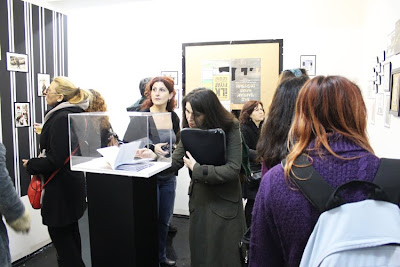
29 Ocak 2012 Pazar
28 Ocak 2012 Cumartesi
24 Ocak 2012 Salı
23 Ocak 2012 Pazartesi
haber - today's zaman
UBIK Project questions realities of 21st century

Set in 1992, the novel tells how technology has advanced to the extent of permitting civilians to reach the moon by creating and contemplating new concepts that have now become the essential material for the exhibition “UBIK Project” at the Hayaka Artı, in İstanbul's Tophane quarter.
Organized by coordinators and artists Alper T. İnce and Rafet Arslan, the exhibition is composed of interdisciplinary works based on concepts and ideas derived from the novel. Among the artists, there are alt komşu, Anti-Pop, Andrea Buran, cins, Eda Gecikmez, Dilara Hançer, OnstOn, Gamze Özer, Ali Mete Sancaktaroğlu/Defter Kazıyıcılar Kooperatifi, Merve Şendil, Hannah M.G. Shapero, Nezaket Tekin and Çağdaş Ülken besides İnce and Arslan.
“We inherited the concept of the exhibition from Dick,” says İnce in an interview with Today's Zaman. “We have many of his books translated into Turkish, and we are interested in the concepts that he created. And when this book was translated into Turkish for the second time, we thought it would be a good idea to organize an exhibition about the book since the novel comprises a lot of visual images. After we decided on holding the exhibition, the second step was to agree upon the conceptual structure.”
“We made a call to artists [whom we knew] were familiar with such themes and many of them agreed to work with us,” explains Arslan. “After that, we formed a UBIK working group from August until the day that we opened the exhibition. It was a process of brainstorming when everybody read the book and discussed it. We found the sub-texts of the novel, and all the works that you see in the exhibition are the embodied forms of the images in the novel.”
Interpreting the world through ‘Ubik'
While Arslan notes that they do not hold mixed exhibitions but conceptual exhibitions, he and İnce point out that it is not compulsory to have read the book in order to visit the exhibition.
“We can't say that those who haven't read the book cannot understand anything about the exhibition,” says İnce. “Even a person who has never heard of the book can come and experience the same aesthetic taste here and try to conceive what is being told in this exhibition. But it is a fact that those who have read the book will have a special taste.”
Confirming İnce, Arslan emphasizes that it was the outcome of the working group's discussions. “From the very beginning, we have never thought of this exhibition as the illustration of the novel,” he says. “Rather, everybody created his or her own universe of Ubik and for this reason everybody will be able to derive various interpretations about the exhibitions.”
Nevertheless, the works at the exhibition are largely based on very essential and characteristic concepts and ideas of the novel, such as the madness of consumption. “There are advertisements at the beginning of every chapter in the novel,” explains İnce. “This is a reference Dick makes to the madness of consumption. And it was indispensable for us to work on this idea.”
“The madness of consumption is something that makes the human soul infertile,” indicates Arslan. “In this novel, there is the search for spiritual freedom under the pressure of the material world created by consumption. And within this context, Dick always asks this question: Where is the human being in this system? The human being has his or her own conscience and conception and he or she faces many systems that they cannot control.”
The works in the exhibition draw attention to questioning the consumption and the realities imposed on people. “Everybody has become a barcoded item,” says İnce. “There is no way of escaping this process; we are monitored wherever we go, and this is the only reality today.”
“We are continuously bombarded by information,” notes Arslan, “but when we take a look at the situation of humanity in the 21st century, we can see that there's enormous misery: spiritual misery as well as material misery. As Jean Baudrillard says, ‘today we live in the imaginary world of the screen,' so one of the main themes of this exhibition and the novel is the questioning of whether reality is actually being manipulated or not, whether we have become barcoded items or not, and whether we are robots created by different ideologies or not.”
For İnce and Arslan, the same process operates on the art community as well. “Who is the most successful artist today?” asks İnce and answers, “The one who sells the most.” “And this proves that the field that should be most free is under the domination of the system,” adds Arslan.
Noting that they don't organize exhibitions about local and current issues, Arslan says that they tend to develop a universal stance consisting of long-lasting works of art. “A person who has just graduated from fine arts has two options,” says Arslan. “One is to do what he or she wants and to live a life of misery, and the other is to accept the norms of the market and be unhappy. For this reason, such independent exhibitions are significant in terms of breaking the domination of the art sector on art.”
While the exhibition can be visited until Jan. 28, the exhibition comprises works that are not limited to the exhibition space. For instance, “Ubik Kullanma Kılavuzu: Oyun Tadında! Talimatlara Uyulduğunda Zararsızdır” (Ubik Instructions Manual: Game Flavored! Harmless if used as instructed) by Nezaket Tekin and Çağdaş Ülgen is an interactive work that can be accessed on the website (www.cagdasulgen.com/ubik.swf) as well as the computer located in the exhibition space.
Arslan and İnce are working on a new project to be exhibited in May 2012, namely “Gerçeklik Terörü” (The Terror of Reality).
http://www.todayszaman.com/news-269248-ubik-project-questions-realities-of-21st-century.html




















































